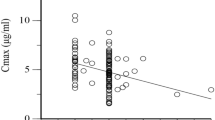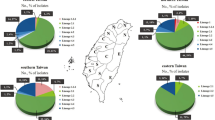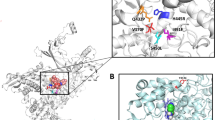Abstract
INACTIVATION by acetylation of the anti-tuberculosis drug isoniazid in vivo is subject to genetic polymorphism1–3. Studies of the gene frequency for rapid inactivation in different regions have revealed considerable racial variations4–7. Because of the association of isoniazid neuropathy with slow inactivation of the drug in therapeutic practice8,9, the recording of gene frequencies among different races and in different countries is of practical importance. It is also of ethnological value in studies of population migrations. This communication reports such an investigation among Burmese subjects.
This is a preview of subscription content, access via your institution
Access options
Subscribe to this journal
Receive 51 print issues and online access
$199.00 per year
only $3.90 per issue
Buy this article
- Purchase on SpringerLink
- Instant access to full article PDF
Prices may be subject to local taxes which are calculated during checkout
Similar content being viewed by others
References
Knight, R. A., Selin, M. J., and Harris, H. W., Trans. Eighteenth Cogn. Chemother. Tuberc., 52 (Veterans Administration, Washington, 1959).
Evans, D. A. P., Manley, K. A., and McKusick, V. A., Brit. Med. J., ii, 485 (1960).
Evans, D. A. P., and White, T. A., J. Lab. Clin. Med., 63, 387 (1964).
Harris, H. W., Knight, R. A., and Selin, M. J., Amer. Rev. Tuberc. Pulm. Dis., 78, 944 (1958).
Sunahara, S., Urano, M., and Ogawa, M., Science, 134, 1530 (1961).
Gangadharam, P. R. J., Bhatia, A. L., Radhakrishna, S., and Selkon, J. B., Bull. WHO, 25, 765 (1961).
Dufour, A. P., Knight, R. A., and Harris, H. W., Science, 145, 391 (1964).
Devadatta, S., Gangadharam, P. R. J., Andrews, R. H., Fox, W., Ramakrishnan, C. V., Selkon, J. B., and Velu, S., Bull. WHO, 23, 587 (1960).
Mitchison, D. A., in Drugs, Parasites and Hosts (edit. by Goodwin, L. G. and Nimmo-Smith, R. H.), 267 (Churchill, London, 1962).
Maher, J. R., Whitney, J. M., Chambers, J. S., and Stanonis, D. J., Amer. Rev. Tuberc. Pulm. Dis., 76, 852 (1957).
Author information
Authors and Affiliations
Rights and permissions
About this article
Cite this article
SMITH, S., KYI, T. Inactivation of Isoniazid in Burmese Subjects. Nature 217, 1273 (1968). https://doi.org/10.1038/2171273a0
Received:
Issue date:
DOI: https://doi.org/10.1038/2171273a0
This article is cited by
-
Zur Anwendung von Sulfamethoxypyrazin bei Personen mit Mangel der Glucose-6-Phosphat-Dehydrogenase der Erythrocyten
Klinische Wochenschrift (1970)



